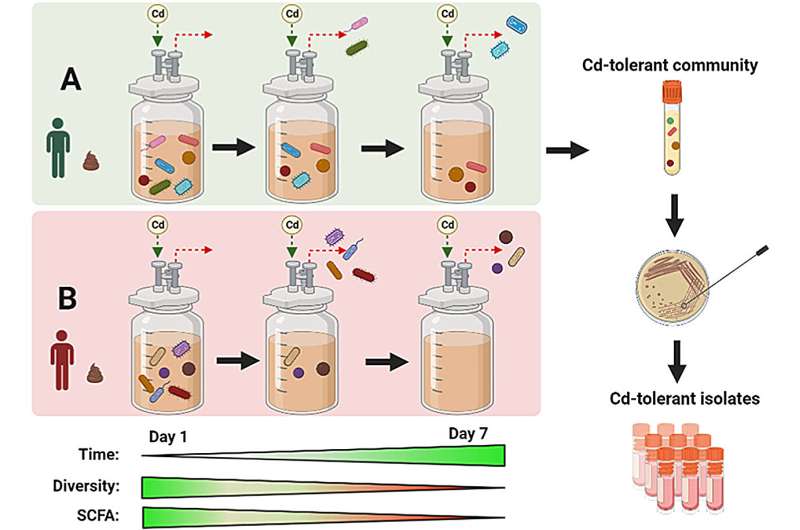Credit: Chemosphere (2023). DOI: 10.1016/j.chemosphere.2023.139581
As a heavy metal that can persist in the human body for decades—and enter it by accumulating in fruits and vegetables—cadmium contributes to cancers of the kidney, lung and prostate, among other organs.
But research has indicated that cadmium also disrupts the delicate balance of the microbiome: the trillions-strong ecosystem of microorganisms living in the gut, where they sway the function and dysfunction of numerous systems. Identifying beneficial bacteria, or probiotics, that might buffer against cadmium's presence there has emerged as a popular but still-preliminary approach to the problem.
Devin Rose, Jennifer Auchtung, Hollman Motta Romero and colleagues decided to hunt for bacterial species that can withstand cadmium and potentially help their more susceptible brethren do the same. The Nebraska team began by extracting samples of the microbiomes from two healthy adults (A and B), cultivating them in bioreactors, then introducing them to toxic levels of cadmium.
Though the cadmium diminished the diversity of species in Microbiome A, the team found that a few did manage to survive and grow amid high concentrations of the toxic contaminant. Conversely, Microbiome B generally withered in the face of even modest concentrations, hinting that cadmium resistance may differ across human guts.
The researchers went on to spike Microbiome B with A's cadmium-tolerant species before again exposing it to the heavy metal. Supplemented by those hardier species, Microbiome B produced higher amounts of butyrate, a vital fatty acid produced by beneficial gut bacteria—and one previously depleted by the cadmium. That suggests the cadmium-tolerant species, which do not produce butyrate themselves, might ward off enough cadmium to help protect its vulnerable cousins against the toxicity of the contaminant.
The team stressed the need for further experimental evidence to confirm the safety and effectiveness of the cadmium-tolerant species identified in their study. And other species might ultimately prove more promising candidates for the job. The work is published in the journal Chemosphere.
But in demonstrating a method for sussing out and testing those candidates, the study represents a serious step toward mitigating cadmium's punch to the gut, the researchers said.
More information: Hollman A. Motta-Romero et al, Toxicity of cadmium on dynamic human gut microbiome cultures and the protective effect of cadmium-tolerant bacteria autochthonous to the gut, Chemosphere (2023). DOI: 10.1016/j.chemosphere.2023.139581
Journal information: Chemosphere
Provided by University of Nebraska-Lincoln
























